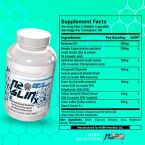Sign up to Get FREE Steroids, SARMS, Peptides eBooks
Ask any of the elite who has become truly massive beasts which anabolic substance has had the most profound effect upon their physique and the answer from the largest bodybuilders will unanimously be insulin. Though GH has been brought to the forefront of competitive stages, the well retained, lean muscle mass displayed beneath the onion skin exterior of today's top bodybuilders is owed to the relationship insulin has with all other physical enhancement chemistry. Insulin, my friends, is what has made beasts what they are in the new millennium.
Right now, I'd like to present an excerpt from Chemical Muscle Enhancement by the anabolic steroid Guru Author L. Rea. The excerpt "Big Fat Bastards and Insulin" is about, using the storage hormone insulin for making the absolute most amazing gains possible. But watch out! Although highly anabolic to muscle, insulin is also highly anabolic to fat and if used improperly, it can be deadly.
Big Fat Bastards and Insulin -- Part One
Nothing in this article is intended to take the place of advice from a licensed health professional. Consult a physician before taking any medication.
Ask any of the elite who has become truly massive beasts which anabolic substance has had the most profound effect upon their physique and the answer from the largest mammals will unanimously be insulin. Though GH has brought to the forefront of competitive stages the well retained lean muscle mass tissue displayed beneath an onion skin exterior of today, it is the symbiotic relationship insulin has with all other physical enhancement chemistry that has made beasts what they are in the new millennium.
Insulin is predominantly a storage hormone in that it initiates a cascade of cellular events that result in up-regulation of cellular nutrient content. It obviously goes without saying then that supraphysiological plasma levels of insulin result in supraphysiological cellular levels of nutrients. This in itself allows for a highly anabolic effect known as an osmotic response. A cellular osmotic response is nothing more than an increase in water and growth potentiating nutrients intracellularly that has an effect similar to increasing the amount of air in a balloon. More air in the balloon means a larger balloon. More water and proportionate growth nutrients means a larger cell. Interesting enough is the fact that this also triggers another survival mechanism that tells the stretched cell wall to increase in thickness to accommodate the osmotic response. This is due to an up-regulation in localized IGF-1 and MGF production and the synergistic response initialize. Oh ya. That is anabolism in the form of hypertrophy. Unfortunately, insulin is quite anabolic to fat cells too.
Since insulin is the body’s main "storage" hormone it should come as no surprise to the reader that many diabetics and would-be beasts alike have become horribly fat as a result of improper insulin use and misguided dietary habits. Many bodybuilders have employed the 10-15 grams of carbohydrates per IU of insulin-administered protocol with a great deal of success in spite of the inherent dangers of non-medical insulin use. However many, who have either become insulin resistant/insensitive or are genetically predisposed to inordinate adipose (fat) tissue accumulation, have endured a greater anabolism of adipose tissue than muscle. Some have foolishly put on more covering clothing and simply accepted this as a necessary side effect endured for the greater eventual goal. Others have added the additional potential negative side effects of heart arrhythmia/tachycardia, diabetes, and other not so fun stuff as well.
As I have pointed out many times before, adipose tissue is a major site for aromatase enzyme activity, which in itself compounds the Big Fat Bastard problem. Many AAS (anabolic/androgenic steroids) are susceptible to the effects of aromatase enzyme conversion to estrogens as is endogenously produced (made inside the body) androgens such as testosterone. Obviously the greater the volume and activity of this enzyme that exists in the body, the greater the chance and degree of aromatization that occurs. Estrogen is directly anabolic to a minor degree to muscle tissue. Both fortunately and unfortunately it is highly anabolic to adipose tissue. Since estrogen is the hormone that induces female pattern fat deposits it is fortunate because a nice rack is a thing of beauty. Unfortunately I have as of yet not noted a single male bodybuilder who looked good or happy with boobs or any other fatty female attributes. So a greater degree of adipose tissue accumulation from insulin administration results in a compounded adipose tissue storage effect from aromatase enzyme susceptible AAS employment.
In some instances the result of this vicious cycle is bodybuilders who fail to ingest adequate calories during AAS protocols as a means of decreasing adipose tissue accumulation. Unless you are from another planet you realize this also limits muscular growth potential as well.
Before we discuss all of the interesting facts concerning the means of becoming a big fat bastard, it is necessary to have a fundamental understanding of the macronutrient product glucose.
GLUCOSE
Glucose is the body’s preferred energy substrate. Though the brain’s nutrient make-up is nearly 1/3 omega-3 fatty acids it is glucose that is without fail mandatory for continued sentience. So carb up a little and read closely as we learn a few things about the body we have been entrusted to play nice with.
When we ingest food stuffs in the form of the three macronutrients protein, carbohydrates, and fats the GI track introduces a series of chemical Action/Reaction Factors that result in the break-down of these nutrients to metabolic substrates.
- Proteins = amino acids
- Carbohydrates = glucose
- Fats = fatty acids
It appears simple on the surface but in fact glucose can be converted to triglycerides and adipose tissue or lean tissue glycogen stores and toilet tinkle. Like wise fatty acids can be stored as fat or utilized as an energy substrate by the body’s tissues but it cannot be converted to glucose. This is interesting when one considers the fact that carbohydrates can become glucose or fat, but fat cannot become glucose (though the cellular mitochondria can use fatty acids as an energy substrate as a keto response). Protein is ultimately destined to become amino acids employed for cellular repair and growth or intimate moments with the bathroom. But certain amino acids called gluconeogenic amino acids can be converted to glucose too. This can be disastrous for a bodybuilder who hopes to be a beast one day since lean muscle mass is predominantly made up of protein in the form of amino acids and a complete spectrum is necessary. We will get to this later. For now simply accept that glucose is necessary for life and bodybuilding progress alike.
The average circulatory value for glucose allows for about only 4 grams of glucose. It is actually uncommon for blood glucose levels to rise beyond an additional 1.5-2.0 grams or to drop below the 4 gram mark. A healthy individual who ingests a meal containing 50-150g of mixed carbohydrates will realize the normal increase in circulatory glucose for only about an hour. Interesting thing here is that endogenous (made by the body) insulin secretion will remain elevated for an additional 2 hours after glucose clearing. When the same individual ingests 300g of carbs (Fat Bastard) at one time the resulting insulin secretion levels will be 300% above normal for an additional 7 hours after blood glucose clearing. This is clearly a highly anabolic environment, but after tissue glycogen stores reach maximum levels a grotesque amount of the excess glucose finds its way to adipose tissue. And don’t worry. If all of the existing fat cells are full, the body is way to happy to make new ones to secrete lots of aromatase enzyme. And herein awaits the key to greater lean mass tissue and a decrease in adipose tissue.
GLUCONEOGENESIS
Gluconeogenesis is the biosynthesis of new glucose. This means that glucose is synthesized from other substrates than carbohydrates or glycogen stores. Obviously since the only source of fuel for the brain, testes, kidneys, and erythrocytes is glucose the body in its amazing adaptive manner can manufacture glucose from other materials. Those who are up on keto diets are aware of the fact that the body can derive energy from ketone bodies (which are converted into acetyl-CoA). But that is an entire different topic for now. In short the body utilizes the carbon structures within substrates to create energy in the eventual form of ATP (adenosine triphosphate). ATP is cellular energy that, as readers are aware, is the body’s only energy currency. In the case of gluconeogenesis the carbon structures can come from other sources.
Triglycerides are structures consisting of three fatty acids adjoined by a glycerol molecule. By cleaving the fatty acids away from the glycerol molecule the body can utilize the freed glycerol molecule to make glucose through a series of conversions and subsequent carbon utilization.
With the exception of lysine and leucine all 20 (or 22 if you are of that school of thought) amino acids can be turned into TCA cycle intermediates which in turn allows for the carbon skeletons of the amino acids to be converted to pyruvate. The newly formed pyruvate can then be utilized by the gluconeogenic pathway to create glucose by way of another series of metabolic pathways. Let me explain that a little better. When glycogen stores in the liver and muscle are depleted the working/recovering muscles, brain and organs need another energy source. Catabolism of muscle tissue proteins to amino acids becomes the main source of carbon skeletons for the maintenance of mandatory blood glucose. As you will recall the body can clear 50 –150 grams of carbohydrates in only a few hours.
So how much muscle do you think the gluconeogenic adaptive process can munch in the same period of inadequate nutrient supply from diet? By the way, the amino acid Alanine is the favorite gluconeogenic snack with Arginine and Glutamine coming in as close seconds.
THINK ABOUT IT
In the presence of circulatory insulin elevation gluconeogenesis in the liver and muscle tissue decreases. During periods of circulating supraphysiological levels of amino acid muscle catabolism decreases. In the presence of both protein synthesis occurs.
So it would seem that the two choices a wanna-be beast faces is 300 grams of carbohydrates to induce a sufficient prolonged insulin spike and a Big Fat Bastard pose down or non-stop keto diets and declarations of "Hey, I may look like a weenie but I am really cut" for life.
- The obvious solution is an elevation in both circulatory insulin and a corrected amino acid pool rendered highly efficient by design and not by chance.
Insulin administration is nothing new to the larger beasts of the bodybuilding world. Unfortunately neither is Big Fat Bastard status in the brief off-season. So it should come as no surprise to those who have entered the realm of the chemically enhance athlete to learn that insulin can make even the best genetically predisposed individual fat. It has been my experience that this is simply not necessary.
Insulin forces excessive amounts of amino acids into muscle cells when an adequate supply exists at the time of insulin exposure. Insulin also triggers increased muscle cell glycogen synthesis by way of positively effecting the rate limiting enzyme glycogen synthase. We also know the positive effects correct application of supraphysiological insulin levels has had upon the most catabolic pathway there is that affects muscle mass from reading my two prior books. Add to this the fact that insulin is synergistic to and with all other chemicals of muscular enhancement and realize the potential.
In relationship to goals it would seem evident that a protocol employing the attributes of insulin would necessitate the symbiotic relationship the hormone has with macronutrients as it applies to lean muscle mass tissue.
- Muscle is more than 80% protein by dry weight.
- ATP is the energy currency of muscular contractions, repair, and growth.
- Glucose is the prime source substrate for ATP synthesis and mandatory for proper brain and organ function (yes, that one also).
- Excess blood glucose will result in excess adipose tissue accumulation.
Here's the link to Big Fat Bastards and Insulin -- Part Two
[sc:signoff-std]




